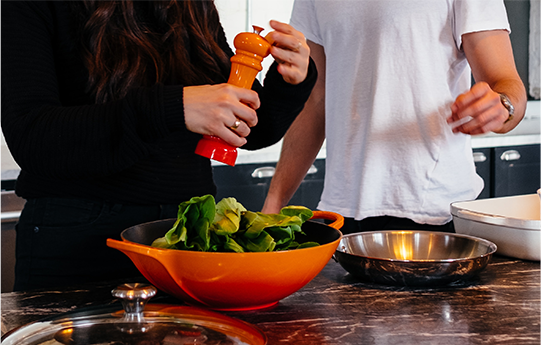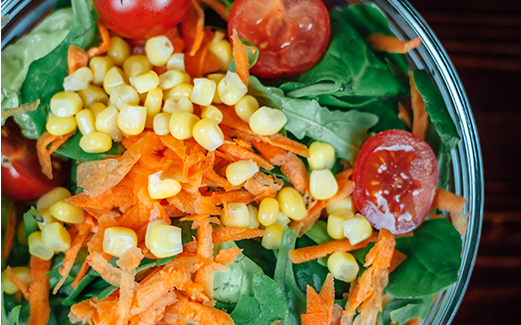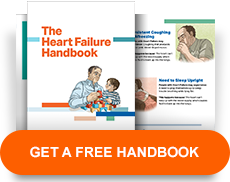Eating less salt
Too much salt can cause your body to retain water, which can create an added burden on your heart.

What’s your salt limit?
Your doctor may give you a salt limit measured in milligrams (mg) of sodium per day. Ordinary table salt is 40% sodium, which equals less than one teaspoon of salt a day. Try using spices and herbs instead of salt to give your food more flavor.

Embrace a low-salt diet
When your doctor asks you to adopt a low-salt diet, it may mean changing a lifetime of eating habits. Start with this collection of appetizing recipes.
Eating Heart-healthy Starts in the Kitchen
Here are hundreds of delicious low-sodium recipes that prove
low salt doesn’t mean no flavor.
Eating Heart-healthy Starts in the Kitchen
Here are hundreds of delicious low-sodium recipes that prove low salt doesn’t mean no flavor.
START SEARCHING NOWBefore you buy the
food, check the
label
At the supermarket, take a few seconds to read the nutrition labels.
Avoid packaged and prepared foods, like frozen dinners—as well as convenient grab-and-go standbys high in salt, like:
-
Bread, rolls, bagels
-
Cold cuts and cured meats
-
Pizza
-
Soup
-
Sandwiches
-
Poultry
Sneaky Salts
Even if you’re not adding salt to your food, sodium has a way of sneaking into your diet. Takeout food, processed foods, even “low-calorie” meals may contain too much salt. Try using spices and herbs to give your food a little flavor.
Add these foods to your shopping list*
Healthy eating with Heart Failure is about eating less of the foods that are bad for your heart, and more of the important nutrients, such as these.
Healthy eating with Heart Failure is about eating less of the foods that are bad for your heart, and more of the important nutrients, such as these.
Swipe to view more

Vegetables
-
Dark green leafy vegetables
-
Green beans
-
Peas
-
Red/orange vegetables like peppers and carrots
More 
Vegetables
-
Dark green leafy vegetables
-
Green beans
-
Peas
-
Red/orange vegetables like peppers and carrots
Fruits
-
Apples
-
Oranges
-
Pears
-
Berries
-
Avocados
More 
Fruits
-
Apples
-
Oranges
-
Pears
-
Berries
-
Avocados
Whole Grains
-
Oatmeal
-
Brown rice
-
Quinoa
-
Bulgur wheat
More 
Whole Grains
-
Oatmeal
-
Brown rice
-
Quinoa
-
Bulgur wheat
Seafood
-
Salmon
-
Trout
-
Tuna
-
Sardines
-
Substitute fish for meat or poultry twice a week
More 
Seafood
-
Salmon
-
Trout
-
Tuna
-
Sardines
-
Substitute fish for meat or poultry twice a week
Nuts & Seeds
-
Walnuts
-
Sunflower seeds
-
Unsalted almonds
-
Pistachios
More 
Nuts & Seeds
-
Walnuts
-
Sunflower seeds
-
Unsalted almonds
-
Pistachios
Olive Oil
-
Use instead of solid fats like butter or margarine
More 
Olive Oil
-
Use instead of solid fats like butter or margarine
Dairy
-
Skim milk
-
Low-fat yogurt
-
Low-fat cheese
More 
Dairy
-
Skim milk
-
Low-fat yogurt
-
Low-fat cheese
Nuts & Seeds
-
Walnuts
-
Sunflower seeds
-
Unsalted almonds
-
Pistachios
More 
Nuts & Seeds
-
Walnuts
-
Sunflower seeds
-
Unsalted almonds
-
Pistachios
Olive Oil
-
Use instead of solid fats like butter or margarine
More 
Olive Oil
-
Use instead of solid fats like butter or margarine
Dairy
-
Skim milk
-
Low-fat yogurt
-
Low-fat cheese
More 
Dairy
-
Skim milk
-
Low-fat yogurt
-
Low-fat cheese
*Talk to your doctor about whether you’re getting the right nutrition and
whether you should get advice from a dietitian or nutritionist.
*Talk to your doctor about whether you’re getting the right nutrition and
whether you should get advice from a dietitian or nutritionist.
Want more ideas on better eating with Heart Failure?
For suggestions on eating healthier and a useful guide on calculating salt content, register for the Keep It Pumping resource program, including your free Heart Failure Handbook.
For suggestions on eating healthier and a useful guide on calculating salt content, register for the Keep It Pumping resource program, including your free Heart Failure Handbook.





